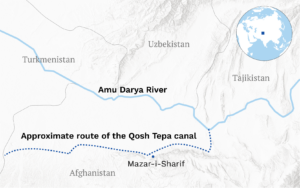
Afghanistan’s Canal Project Looks to Deepen Uzbekistan and Turkmenistan’s Water Woes
Publication: Eurasia Daily Monitor Volume: 21 Issue: 36
By:

Executive Summary:
- Uzbekistan, Turkmenistan, and Afghanistan are facing severe water shortages, which Kabul plans to counter with the Qosh Tepa canal, which will likely exacerbate water issues in Central Asia.
- Uzbekistan’s and Turkmenistan’s economies largely rely on agriculture, and the canal project would detrimentally affect agricultural production through increased salinization and a sharp decline in water flow to both countries from the Amu Darya River.
- New agreements regarding water management between Afghanistan and the Central Asian republics are needed to set a precedent for regional cooperation in sustainable water management.
Uzbekistan is currently facing a severe water shortage for agricultural needs. According to regional experts, the deficit could reach 7 billion cubic meters by 2030 and double by 2050 (Times of Central Asia, February 13). Similarly, Ashgabat is searching for lasting solutions to its water woes. Turkmenistan and Uzbekistan represent two of 17 countries facing “extremely high” levels of baseline water stress (Progres, June 28, 2023). Both countries border Afghanistan, where the construction of an irrigation canal is bound to deepen the water woes of both Central Asian republics (CARs). In September 2023, Uzbekistan’s President Shavkat Mirziyoyev raised concerns about the Qosh Tepa canal in Afghanistan at the Council of Heads of the Founder States of the International Fund for Saving the Aral Sea. Mirziyoyev asserted that the canal’s introduction “could radically change the water regime and balance in Central Asia” (Ariananews.af, September 16, 2023).

The Taliban has termed the canal project as a lifeline for drought-ridden Afghanistan. The canal is being constructed on the Amu Darya River in the country’s northern Balkh province. The project aims to turn some 550,000 hectares of desert land into arable farmland in Afghanistan’s arid northern provinces of Kaldar, Balkh, Jowzjan, and Faryab (Daryo, July 26, 2023).
Water distribution among the CARs from the Amu Darya basin is based on the “agreement on cooperation in joint management, use, and protection of interstate sources of water resources” signed by the Ministers of Water Resources of Central Asian States in 1992. Before this, Soviet officials had signed an agreement in Moscow known as “Protocol 566” to guide the allocation of water resources in Central Asia. The protocol also created the River Basin Organizations to manage quotas. As the Soviet Union began to collapse, the five CARs signed a new agreement “on cooperation in joint management, use, and protection of interstate sources of water resources” (Icwc-aral.uz, accessed March 6). The accord created the Interstate Commission for the Water Coordination of Central Asia (ICWC), which does not include Afghanistan, to oversee the distribution of water resources. Afghanistan’s construction of the Qosh Tepa canal now looks to disrupt that system (Azatlyk Radiosy, March 29, 2023).
The 285-kilometer-long, 100-meter-deep canal is expected to cost $684 million and is scheduled to be completed by 2028 (Prodrobno, December 14, 2022). The Taliban is funding the project from its own resources, largely generating funds by selling mining rights in Afghanistan, primarily to Chinese companies. Over 200 Afghan companies are engaged in the construction of the canal (Tolo News, December 13, 2022).
The Amu Darya’s waters make up 80 percent of all accessible water resources in the region. Thus, the Qosh Tepa canal will seriously affect the CARs, especially Uzbekistan and Turkmenistan (CABAR-Asia, July 22, 2023). According to some experts, the two countries may lose up to 15 percent of the irrigation water they draw from the river (Intellinews, March 17, 2023). Once the canal is completed, almost a third of the Amu Darya’s waters will flow into the interior of Afghanistan. Several regions of Uzbekistan and Turkmenistan will consequently witness a sharp decline in the volume of accessible water (Kun.uz, February 13, 2023).
Kabul also plans to build the Dasht-i-Jun hydroelectric complex to gain greater control over the flow of the Panj River. Environmental expert Natalya Shulepina pointed out that “taken together, these two large projects will lead to a sharp decrease in the release of [water resources] to the territories of Turkmenistan and Uzbekistan” (Prodrobno, December 14, 2022).
The Taliban’s diversion of the Amu Darya River’s flow to Afghan territory will heavily hamper Turkmenistan’s agricultural sector. Turkmenistan relies on the Amu Darya River for about 90 percent of its water supply. “This is not a problem; this is a catastrophe,” said a hydrogeology expert from Turkmenistan. “This is a big threat, undoubtedly. Not only because of the loss of water, there are many factors, and they can all work together to complicate the water situation sharply” (Azatlyk Radiosy, March 30, 2023).
The canal will seriously impact agriculture in Uzbekistan. The country relies heavily on agriculture, with nearly 40 percent of the population, directly or indirectly, associated with the sector. With 4.5 million hectares of arable land, Uzbekistan primarily cultivates cotton, wheat, barley, rice, corn, potatoes, fruits, and vegetables. The decline in water resources will likely deal a serious blow to Tashkent’s cotton industry (CABAR-Asia, July 22, 2023). As cotton accounts for 17 percent of Uzbekistan’s gross domestic product, the domestic economy will also suffer (EuroAsiaNet, October 19, 2023).
Uzbekistan has already been dealing with water shortages, drought, and desertification. Climate change and general drought are major causes of Uzbekistan’s depleting water resources. Uzbek scientist Usmon Norkulov warned, “We are losing 15 percent of water due to climate change, and if we lose another 10 percent, one-quarter of [our] water will be lost. This causes many crises. It will be difficult for us to fill the reservoirs. We will have to build additional facilities. The whole system might break down” (Kun.uz, February 13, 2023).
Turkmenistan and Uzbekistan could face additional problems beyond the loss of water resources. Some experts believe the canal could bring widespread salinization in Afghanistan and the region. “The canal, almost at right angles, crosses or skirts foothill plains, river deltas that have their own established hydrological and hydrodynamic regime,” a Turkmen expert pointed out. “This will disturb the current groundwater drainage into the Amu Darya, resulting in a rise in the groundwater level and salinization of agricultural land” (Third Pole, May 18, 2023). Widespread salinization causes severe damage to agricultural land, as the excess salt causes the soil to lose fertility.
The main issue for Turkmenistan and Uzbekistan is the lack of an agreement on the distribution of the Amu Darya’s waters between Afghanistan and the CARs. Some analysts suggest that Kabul should be better integrated into Central Asia’s water management regime. New agreements between Afghanistan and the CARs are needed to set a precedent for regional cooperation in sustainable water management (Third Pole, May 18, 2023). Sustained water shortages could exacerbate domestic and regional tensions, resulting in future conflict.



